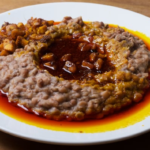In the colorful and diverse culinary landscape of South Africa, Cape Malay cuisine stands out for its unique blend of flavors influenced by the Malay and Indonesian communities. One dish that embodies the rich heritage of Cape Malay cuisine is Pickled Fish. This delightful dish combines the vibrant flavors of spices and tangy vinegar with tender fish, creating a symphony of tastes that is both spicy and tangy.
Origins and Cultural Significance
Pickled Fish holds a significant place in Cape Malay culture and history. The dish has its roots in the Cape Malay community, which traces its heritage back to the slaves and political exiles from the Dutch East Indies who settled in Cape Town during the 17th century. These influences, combined with local ingredients, gave birth to a unique culinary tradition that has been passed down through generations.
Traditionally, Pickled Fish was prepared as a way to preserve fish during the Lenten season, when meat consumption was restricted. It was often served on Good Friday as part of the Easter festivities, and it remains a beloved dish that is enjoyed year-round.
The Flavors and Ingredients
The distinct flavors of Cape Malay Pickled Fish come from the combination of spices and the tangy pickling liquid. The fish, typically firm white fish such as yellowtail or snoek, is marinated in a mixture of spices, including curry powder, turmeric, coriander, cumin, and ginger. These spices create a fragrant and aromatic blend that infuses the fish with rich flavors.
The fish is then lightly coated in flour and pan-fried until golden and crispy. Meanwhile, a tangy pickling liquid is prepared, consisting of vinegar, sugar, onions, garlic, and a variety of pickling spices such as mustard seeds, bay leaves, and cloves. The pickling liquid is heated until the flavors meld together, creating a balance of sweetness and tanginess.
Once the fish is cooked and the pickling liquid is ready, the fish fillets are layered in a glass or ceramic dish, alternating with slices of onions and the pickling liquid. The dish is then left to marinate in the refrigerator for at least 24 hours, allowing the flavors to develop and intensify.
The Taste Experience
The first bite of Cape Malay Pickled Fish is a journey of flavors. The crispy and succulent fish is beautifully complemented by the tangy and spicy pickling liquid. The combination of spices provides warmth and depth, while the tanginess of the vinegar adds a refreshing and zesty element to the dish. The pickling process tenderizes the fish and infuses it with the flavors of the marinade, resulting in a delightful balance of textures and tastes.
Serving and Accompaniments
Cape Malay Pickled Fish is typically served chilled or at room temperature. It is often enjoyed as a main course or as a side dish alongside other Cape Malay favorites, such as fragrant yellow rice, rotis, or sambals. The tangy and spicy flavors of the dish can be enhanced with a squeeze of fresh lemon juice or a sprinkle of chopped fresh coriander.
Cape Malay Pickled Fish is a testament to the diverse flavors and cultural fusion that define South African cuisine. It reflects the history, traditions, and vibrant spices of the Cape Malay community. With its spicy and tangy profile, this dish offers a unique taste experience that delights the senses and showcases the richness of Cape Malay culinary heritage. So, whether you’re exploring the vibrant streets of Cape Town or trying your hand at Cape Malay cooking at home, don’t miss the opportunity to savor the spicy and tangy flavors of Cape Malay Pickled Fish.








